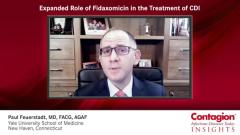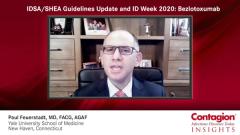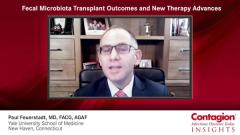
Expanded Role of Fidaxomicin in Treatment of CDI
Episodes in this series

Transcript:
Paul Feuerstadt, MD, FACG, AGAF: At ID [Infectious Diseases] Week in October of 2020, we had a major update to the IDSA/SHEA [Infectious Diseases Society of America/Society for Healthcare Epidemiology of America] guidelines. This update took a provisional format that’s still being reviewed, but was being presented publicly as a precursor to a publication that should come in late 2020 or early 2021. These recommendations built upon the IDSA/SHEA guidelines from 2018. They initially took on the question of initial treatment of C difficile [Clostridioides difficile] infection or primary infection. And when they did a PICO [patient/population, intervention, comparison, outcomes] analysis with updated data, they decided that fidaxomicin, 200 mg twice daily for 10 days, should be used preferentially in front of vancomycin, 125 mg 4 times daily.
How did we get to that recommendation? Let’s look back at some of the literature that built on fidaxomicin. And what is fidaxomicin? Fidaxomicin is a narrow spectrum antimicrobial, meaning it targets C difficile and has a minimal effect on the surrounding colonization resistance, or the surrounding microbiota. By doing that, you treat the C difficile, but you also minimize the collateral damage to the colonization resistance, minimizing risks of recurrence in the future. That’s theoretical, but that has been borne out in several studies, and let’s talk about them.
There were 2 phase 3 prospective randomized controlled trials published in 2011 that compared vancomycin with fidaxomicin head-to-head. Across those trials, 542 patients received fidaxomicin, 200 mg twice daily for 10 days, and 563 patients received vancomycin, 125 mg 4 times daily for 10 days, and then they were followed for 28 days thereafter for recurrence. They initially looked at initial treatment response. And initial treatment response was powered for noninferiority, and fidaxomicin achieved that, with a response rate of 88.2% versus 85.8% with the vancomycin. But what I described before is that fidaxomicin has that narrow spectrum, so it should have decreased rates of recurrence. And in the modified intention to treat analysis, that was achieved with statistical significance. Recurrence rates with vancomycin were 25.3%, whereas recurrence rates with fidaxomicin were 15.4%, a statistically significant difference favoring fidaxomicin.
Many of us practice in the real world and not as part of a prospective randomized controlled trial. The question of how well fidaxomicin performs in the real world came up in a study that was put forward by Simon Goldenberg, MD, et al. This is a study that was based out of the United Kingdom, looking at several medical facilities and health care systems that used fidaxomicin in a variety of ways.
Let’s first focus on using it for initial treatment. They used historical controls for their recurrence rates, and then prospective data for usage of fidaxomicin for initial infection, and in the 2 health care systems that I’m going to quote right now, for all infections. The historical data in health care system A within that study had a recurrence rate of 10.6%. Once fidaxomicin was added, 3.1%, a statistically significant difference. In health care system B, which also used fidaxomicin universally, the historical recurrence rate was 16.3%, versus 3.1% once fidaxomicin was being used. We can see a real significant delta and improvement, or lessening, of recurrence rates when fidaxomicin is being used.
Recurrence is a major problem with C difficile infection. And with this 2020 ID Week update to the IDSA/SHEA guidelines, they recommended using fidaxomicin in front of vancomycin for recurrence as well. Where did that come from? Let’s go back to the study that we were just discussing by Goldenberg, et al. In a group that received fidaxomicin for first recurrence, the historical controls had recurrence rates of 21.1%, versus 12.5% in the prospective group that received fidaxomicin. What we see is, even if fidaxomicin wasn’t used initially but was used for recurrence, recurrence rates decreased.
Now, that’s the real-world application, but there are also prospective randomized controlled data that looked into this, and that was a subgroup analysis of 28% of all the individuals in the pivotal phase 3 trials comparing vancomycin with fidaxomicin. In that group, 28% of the individuals had had C difficile within the prior 3 months. When they looked at the rates of recurrence of the group that then received vancomycin, recurrence rates were 35.5%; the group that received fidaxomicin, 19.7%, a statistically significant reduction in rates of recurrence.
In addition, there’s a more modern study that was published a couple of years ago out of Europe. They looked at 364 individuals hospitalized with C difficile infection and randomized them to either receive vancomycin, 125 mg 4 times daily for 10 days, or a unique application of fidaxomicin, giving it twice daily for 5 days, and then every other day for days 7 through 25, almost a taper of sorts. Overall, initial treatment response in the vancomycin arm was 82.1% versus 80% with fidaxomicin. Noninferior, so they were similar; however, rates of recurrence in the fidaxomicin arm were remarkably lower. Rates of recurrence with vancomycin were 19% versus 6.2% in the fidaxomicin arm, a statistically significant difference. Within this update to the 2018 guidelines, it is now recommended that fidaxomicin be used in front of vancomycin for first recurrence, with consideration either for 1 tablet twice daily for 10 days, or 1 tablet twice daily for 5 days, and then every other day for days 7 through 25.
Transcript Edited for Clarity
Newsletter
Stay ahead of emerging infectious disease threats with expert insights and breaking research. Subscribe now to get updates delivered straight to your inbox.















